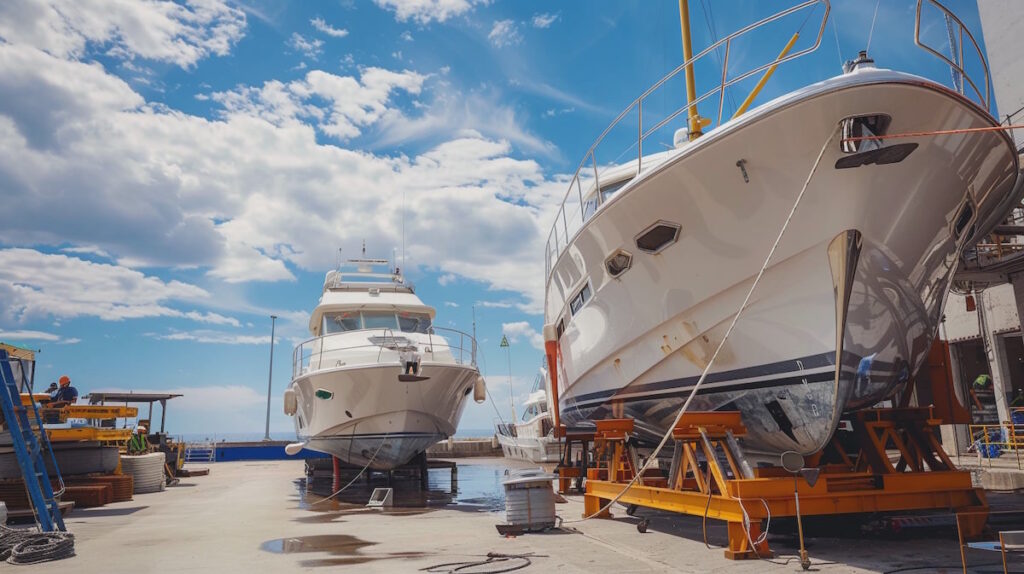Navigating the waters is more than just steering the helm; it involves a complex interplay of various mechanical and electronic systems that ensure a vessel’s operational integrity and safety. Mobile marine mechanics play a critical role in this dynamic, ensuring that boats and ships function optimally through regular maintenance and adept troubleshooting. The work of these professionals is crucial, particularly when vessel owners encounter unexpected mechanical failures that could lead to safety hazards or costly downtimes.
In the world of marine mechanics, the ability to swiftly and accurately diagnose and rectify issues is paramount. This requires a deep understanding of advanced troubleshooting techniques that go beyond the basics of mechanical repair. Today’s marine mechanics are increasingly reliant on a blend of traditional knowledge and cutting-edge technology to address the sophisticated systems found in modern marine vessels.
This blog post delves into the specialized strategies and tools that mobile marine mechanics employ to diagnose and fix complex issues in marine vessels. From utilizing advanced diagnostic software to applying systematic approaches to problem-solving, we will explore how these technicians ensure that every voyage is as safe and smooth as possible. Our journey through this topic will highlight the importance of these advanced skills in maintaining the health and efficiency of various crucial systems aboard, emphasizing the blend of expertise and technology in modern maritime operations.

Understanding Marine Vessel Systems
Navigating the complexities of marine vessel systems requires a comprehensive understanding of the various components and how they interact. Marine vessels, whether small boats or large ships, are equipped with intricate systems that ensure their operational efficiency and safety. Mobile marine mechanics face the challenge of diagnosing and repairing issues across these diverse systems, which include the engine, electrical, fuel, cooling, and steering systems. Each of these components plays a crucial role, and their failure can lead to significant problems, potentially compromising the vessel’s functionality.
Engine Systems
The engine is the heart of any marine vessel, powering everything from small fishing boats to large cargo ships. There are two main types of engines used in marine vessels: diesel and gasoline engines. Diesel engines are prevalent in larger vessels due to their efficiency and durability, while gasoline engines are commonly found in smaller boats. Understanding these engines involves knowing their construction, operation, and common points of failure such as fuel injection issues, exhaust system problems, and cooling inefficiencies.
Electrical Systems
Electrical systems in marine vessels are vital for both operation and comfort. These systems power everything from the vessel’s navigation lights and communication devices to kitchen appliances and air conditioning. Troubleshooting electrical issues requires knowledge of wiring, circuit breakers, and power generation and storage systems, including batteries and alternators. Corrosion, wire fatigue, and faulty connections are common problems that can disrupt the electrical system’s functionality.
Fuel Systems
The fuel system, which includes tanks, pumps, filters, and injectors, is critical for the proper operation of the engine. Issues in the fuel system can lead to engine inefficiency or failure. Common troubleshooting involves checking for blockages, leaks, and contamination. Mobile marine mechanics need to be vigilant about the quality of fuel used and the integrity of the fuel delivery systems.
Cooling Systems
Cooling systems keep the engine from overheating and are essential for its longevity and safe operation. These systems can be either closed (using a coolant in a radiator system) or open (drawing water from the surrounding environment). Problems such as leaks, blockages in the water passages, and malfunctioning thermostats can lead to serious engine damage if not addressed promptly.
Steering Systems
Steering systems in marine vessels can be mechanical, hydraulic, or electronic. Issues with steering systems can be particularly hazardous during navigation. Common problems include leaking hydraulic fluid, worn cables in mechanical systems, and faulty electronic sensors and actuators in more modern installations.
Understanding these systems and their common issues is the first step toward effective troubleshooting. Mobile marine mechanics must be equipped with a broad knowledge base and the ability to apply this knowledge practically. The following sections will delve deeper into the diagnostic tools and specific troubleshooting techniques that enable these professionals to maintain and repair marine vessels efficiently and effectively.
Diagnostic Tools and Technology
The evolution of marine engineering has brought forth sophisticated diagnostic tools and technology that mobile marine mechanics rely on to enhance their troubleshooting capabilities. These advanced tools not only speed up the diagnosis process but also increase its accuracy, allowing for effective repairs and maintenance. This section explores the key diagnostic technologies used in the field and how they integrate with traditional mechanical expertise to ensure marine vessels operate at their best.
Onboard Diagnostic Systems
Modern marine engines are equipped with onboard diagnostic systems (OBDs), similar to those found in automobiles. These systems continuously monitor the engine and other critical components, providing real-time data through sensors and electronic control units (ECUs). When a problem arises, the OBD system records fault codes, which can be read using specialized scanning tools. These fault codes help mechanics identify specific issues quickly, often without the need for extensive manual testing. Mobile marine mechanics use portable diagnostic scanners to access these codes and interpret them to determine the necessary repairs.
Digital Scanning Tools
Digital scanning tools are indispensable in diagnosing modern marine electronics and systems. These tools can interface with various vessel systems beyond the engine, such as electrical networks, navigation systems, and even HVAC units. By connecting to the vessel’s data network, scanners can pull detailed logs and performance reports that help pinpoint inefficiencies and malfunctions. The ability to diagnose issues through software reduces the risk of overlooking potential problems that are not immediately apparent through physical inspection alone.
Software Applications
Many mobile marine mechanics now use specialized software applications designed for marine diagnostics. These applications can run on laptops, tablets, or smartphones, providing powerful diagnostic capabilities right at the fingertips. Software can include features like interactive wiring diagrams, system schematics, and troubleshooting guides specific to different vessel makes and models. This digital reference material allows mechanics to quickly access a vast array of information on-the-go, enhancing their ability to diagnose issues accurately and efficiently.
Remote Monitoring Systems
Advancements in IoT (Internet of Things) technology have led to the development of remote monitoring systems for marine vessels. These systems allow continuous monitoring of a boat’s critical systems from a distance. Data collected from the vessel can be analyzed remotely, and potential issues can be flagged before they develop into serious problems. For mobile marine mechanics, this technology means they can often diagnose problems before physically inspecting the vessel, planning the repair process more effectively and ensuring they arrive with the necessary tools and parts.
Thermal Imaging Cameras
Thermal imaging cameras have become a valuable tool for marine mechanics. These cameras can detect heat signatures from various components, revealing problems like electrical hot spots, overheating motors, or leaking fluids. By visualizing the temperature anomalies, mechanics can identify issues that are invisible to the naked eye, such as poor electrical connections or insulation failures. This tool is particularly useful in preventative maintenance and in conducting thorough checks after repair to ensure that all systems are functioning correctly.
The integration of these advanced diagnostic tools and technologies into the field of marine mechanics has significantly transformed how troubleshooting and repairs are conducted. By combining traditional mechanical skills with modern technology, mobile marine mechanics can provide more precise, efficient, and effective service, ensuring that marine vessels are safe, functional, and ready to face the demands of the water.
Troubleshooting Engine Problems
Engine issues are among the most common and critical problems faced by marine vessels. Efficiently resolving these issues requires not only a solid understanding of engine mechanics but also the ability to apply advanced diagnostic techniques. This section will detail the process by which mobile marine mechanics troubleshoot complex engine problems, focusing on both diesel and gasoline engines typically found in marine settings.
Step-by-Step Guide to Diagnosing Engine Issues
Initial Inspection and Symptom Analysis
- Listen and Observe: Mechanics start by listening to the engine in operation (if possible) and observing any visible signs of distress such as smoke, vibration, or leakage. Each symptom can give clues about the underlying issue.
- Check for Error Codes: Using digital scanning tools, mechanics read any error codes stored in the engine’s computer system. These codes can pinpoint areas such as fuel injection problems, misfires, or overheating.
Detailed Diagnostic Tests
- Compression Test: This test is crucial for assessing the condition of the engine’s cylinders. It can reveal problems like worn piston rings, damaged cylinders, or issues with valves, which might cause the engine to perform poorly.
- Fuel Pressure Test: Proper fuel delivery is essential for engine performance. Mechanics measure the pressure and flow from the fuel pump to ensure it meets specifications for the engine’s make and model.
- Ignition System Diagnostics: For gasoline engines, checking the ignition system is key. This includes testing spark plugs, ignition coils, and distributors to ensure they are providing the necessary spark at the right time.
Advanced Troubleshooting
- Using Borescopes: Borescopes allow mechanics to inspect areas that are not easily accessible, such as the insides of combustion chambers or fuel lines. This non-invasive technique can help identify issues without disassembling the engine.
- Thermal Imaging: Thermal cameras can detect overheating components or abnormal heat patterns in the engine. This helps in identifying blocked cooling passages, failing bearings, or electrical issues that cause excess heat.
Case Studies: Real-World Engine Troubleshooting
Case Study 1: Diesel Engine Overheating
- Situation: A marine diesel engine starts overheating during operation. The mechanic uses thermal imaging to identify a blocked cooling jacket.
- Solution: After confirming the blockage with a borescope, the mechanic cleans the cooling passages and replaces the thermostat, solving the overheating issue.
Case Study 2: Gasoline Engine Misfiring
- Situation: A marine gasoline engine misfires sporadically, leading to unstable performance. Error codes indicate issues with the ignition system.
- Solution: The mechanic replaces faulty ignition coils and worn spark plugs, and adjusts the engine timing. After clearing the codes and retesting, the engine runs smoothly.
Common Pitfalls and Tips
- Avoiding Misdiagnosis: Always double-check diagnostics and consider all potential causes of an observed symptom. Cross-reference symptoms with diagnostic data to avoid costly misdiagnosis.
- Systematic Approach: Follow a structured approach to diagnostics, from simple to complex tests, to ensure no component is overlooked.
- Continual Learning: Stay updated on the latest diagnostic techniques and engine technologies. Modern engines are complex and require ongoing education to troubleshoot effectively.
Troubleshooting engine problems in marine vessels demands a blend of traditional mechanical skills and modern diagnostic techniques. By effectively applying these advanced methods, mobile marine mechanics can ensure that engines not only run smoothly but also sustain their performance over time, ultimately supporting the safety and reliability of marine operations.
Electrical and Electronic System Troubleshooting
Electrical and electronic systems in marine vessels are critical for everything from basic engine operation to navigation and safety. As vessels incorporate more sophisticated technology, the complexity of these systems increases, requiring advanced knowledge and specific diagnostic skills from mobile marine mechanics. This section outlines the detailed approach used to troubleshoot these integral systems, ensuring reliability and functionality.
Understanding the System Components
Before diving into troubleshooting, it’s essential for mechanics to have a thorough understanding of the marine vessel’s electrical and electronic architecture. This includes:
- Power Generation and Storage: Familiarity with how the vessel generates and stores electrical power, including alternators, generators, and battery banks.
- Distribution Networks: Knowledge of the electrical distribution panels, wiring routes, and protective devices such as circuit breakers and fuses.
- Navigation and Communication Devices: Understanding of GPS, radar, sonars, VHF radios, and other communication equipment that are vital for safe marine navigation.
- Entertainment and Living Systems: For larger vessels, systems like satellite television, kitchen appliances, and climate control systems also fall under the purview of the marine mechanic.
Diagnostic Steps for Electrical and Electronic Systems
Visual Inspection and Initial Testing
- Check Connections and Corrosion: Inspect all electrical connections for tightness and signs of corrosion, which can cause significant issues in marine environments.
- Voltage and Continuity Tests: Use multimeters to test for proper voltage levels and continuity across electrical circuits. This helps identify broken wires or faulty components.
Using Advanced Diagnostic Tools
- Digital Multimeters and Clamp Meters: Essential for measuring electrical values accurately. Clamp meters are particularly useful for measuring current without disconnecting the circuit.
- Oscilloscopes: Used to observe the detailed waveforms of electrical signals. This can be crucial for diagnosing problems in electronic communication equipment.
- Network Scanners: Specialized tools that interface with maritime data networks, such as NMEA (National Marine Electronics Association) networks, to diagnose communication issues between devices.
Troubleshooting Common Problems
- Intermittent Electrical Failures: These are often the result of loose connections, chafed wires, or moisture ingress. Systematic checking of all potential fault points is necessary.
- Overloading and Short Circuits: Identify circuits that frequently blow fuses or trip breakers, which may indicate overloading or faults in the wiring or connected devices.
- Faulty Navigation Equipment: Issues might be due to incorrect installation, software errors, or hardware malfunctions. Updating software, recalibrating devices, and replacing defective components are common solutions.
Case Studies: Real-World Electrical Troubleshooting
Case Study 1: Faulty Autopilot System
- Situation: A sailing yacht’s autopilot system fails intermittently, especially in rough weather conditions.
- Diagnosis: The mechanic finds that vibration has loosened a critical wiring connection within the system.
- Solution: After securing the connection and protecting the area from future vibrations with additional padding, the system’s reliability is restored.
Case Study 2: Generator Power Fluctuations
- Situation: The onboard generator of a motor yacht exhibits power fluctuations and occasional shutdowns.
- Diagnosis: Using an oscilloscope, the mechanic identifies irregular waveforms indicating a malfunctioning voltage regulator.
- Solution: Replacing the voltage regulator stabilizes the power output, resolving the fluctuations.
Tips for Effective Electrical Troubleshooting
- Regular Maintenance: Encourage routine inspections and maintenance to prevent electrical issues from developing into serious problems.
- Proper Documentation: Keep detailed schematics and diagrams of the vessel’s electrical systems on hand, as this can significantly speed up the troubleshooting process.
- Safety First: Always prioritize safety when working with electrical systems, especially on water where risks are compounded by the environment.
Troubleshooting electrical and electronic systems aboard marine vessels requires a methodical approach backed by specialized tools and in-depth knowledge of the system’s design and function. By employing these advanced techniques, mobile marine mechanics can ensure that these critical systems maintain their functionality and reliability, thereby supporting the overall safety and efficiency of the vessel.
Conclusion
The realm of mobile marine mechanics is one marked by complexity and continual evolution. As marine vessels become more sophisticated, integrating advanced technologies and systems, the role of the mechanic transcends traditional boundaries. Today’s marine mechanics are not just repairmen; they are highly skilled technicians who employ a mix of traditional mechanical skills and modern technological prowess to ensure the safety, efficiency, and reliability of marine vessels.
Through this exploration of advanced troubleshooting techniques, we’ve seen how vital these skills are across various systems—engine, electrical, fuel, cooling, and steering systems. Each section of our discussion highlighted the need for a detailed understanding of these systems, the use of specialized diagnostic tools, and the application of methodical troubleshooting methods. From leveraging software applications and digital scanning tools to applying hands-on tests like compression checks and thermal imaging, the tools and techniques at the disposal of today’s mobile marine mechanics are as varied as they are effective.
Moreover, the real-world case studies demonstrate not only the challenges faced in the field but also the ingenuity and technical acumen with which these professionals approach and resolve complex problems. These examples serve as a testament to the critical thinking and adaptability required in marine mechanics.
As marine technology continues to advance, so too must the knowledge and techniques of the marine mechanic. Continuous education and training become indispensable in this dynamic field, ensuring that professionals remain at the cutting edge of technology and best practices. For vessel owners and operators, the importance of engaging knowledgeable and skilled mobile marine mechanics cannot be overstressed. Their expertise not only resolves immediate operational issues but also contributes to the long-term health and performance of the vessel, ultimately safeguarding the investments and safety of those aboard.
Hiring a mobile marine mechanic has many benefits, including convenience and efficiency. Mobile marine mechanics can travel to the location of the vessel, saving time and money on transportation costs. They can also provide on-site repairs, reducing downtime for the vessel. Mobile marine mechanics have specialized knowledge and experience in repairing and maintaining marine vessels to ensure the job is done correctly.
If you want to learn more about boating, you might find this article on custom boat covers in Cocoa Beach interesting. This text discusses the importance of protecting your boat from the weather and offers advice on selecting the appropriate cover for your vessel. Whether you’re a seasoned boater or just starting out, understanding the significance of proper boat maintenance is crucial. Check out this informative piece to complement your knowledge of advanced troubleshooting techniques used by mobile marine mechanics. (source)
FAQs
What are advanced troubleshooting techniques used by mobile marine mechanics?
Advanced troubleshooting techniques used by mobile marine mechanics involve the use of specialized tools and equipment to diagnose and repair complex issues in marine engines and systems. These techniques may include computer diagnostics, electrical testing, and mechanical inspections.
What types of issues can be addressed using advanced troubleshooting techniques?
Advanced troubleshooting techniques can be used to address a wide range of issues in marine engines and systems, including electrical problems, mechanical failures, fuel system issues, and more.
How do mobile marine mechanics access and diagnose issues in remote locations?
Mobile marine mechanics use specialized equipment and tools that are designed to be portable and easy to transport to remote locations. They may also use remote diagnostic tools that allow them to access and diagnose issues from a distance.
What are some common tools used by mobile marine mechanics for advanced troubleshooting?
Common tools used by mobile marine mechanics for advanced troubleshooting include multimeters, oscilloscopes, fuel pressure gauges, compression testers, and computer diagnostic tools.
What are the benefits of using advanced troubleshooting techniques for marine repairs?
Using advanced troubleshooting techniques can help mobile marine mechanics diagnose and repair issues more quickly and accurately, reducing downtime and minimizing the risk of further damage to the vessel. This can also help to save boat owners money on repairs in the long run.





